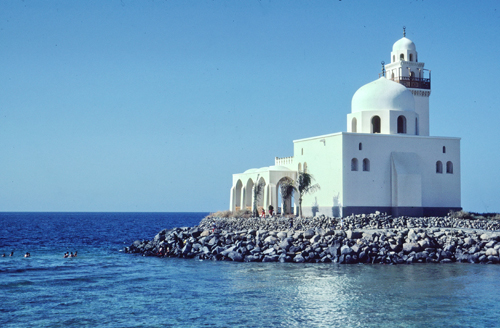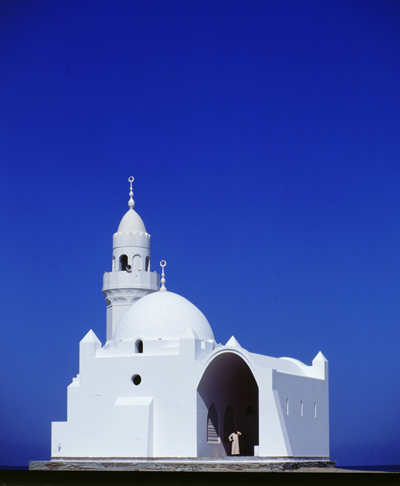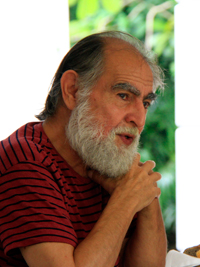Soaring high on tradition

The Island Mosque in Jeddah
The Geoffrey Bawa Memorial lecture given annually to mark the legendary architect’s birthday – July 23 ( it would have been his 99th this year) has always been delivered by an architect of particular eminence. On Thursday, July 26 at the Sri Lanka Foundation Institute the architect who took the podium was one whose singular creativity has been recognised not just in the Arab world, but globally. Abdel-Wahed El-Wakil is regarded as one of the foremost exponents of contemporary Islamic architecture and a new traditionalist.
El-Wakil met Bawa just once in 1989 when he was receiving his second Aga Khan Award in Cairo – he had won his first in 1980. “I was really happy to meet him,” he says, adding that he is here in Colombo out of respect for the great man’s memory, even though he doesn’t travel much any more, weary of the ‘nasty’ airport checks and the tedium of long flights. Before he met Bawa, he had been called the Geoffrey Bawa of the Middle East, in the Aga Khan circles, he smiles. He fell in love with Bawa’s work after seeing a book on him- the serene courtyard houses, sensitivity of design and his beautiful architectural drawings.
There is another great son of this country of a different era whom El-Wakil reveres and whose name he frequently mentions ‘as one of my great teachers’ in lectures to university students – Ananda Coomaraswamy, ‘a man of amazing genius’.
At the SLFI, his talk is on ‘Architecture, art and traditional civilizations’ and it is a wide-ranging, no-holds barred one. Architecture is the footprint of a culture; literature can lie, poetry can praise but architecture always reflects the true history of a culture, he says decrying the current trend towards constructing so-called ‘iconic’ buildings. These buildings are not made by architects but by frustrated sculptors, he tells a startled audience, going on to debunk several reputed names contrasting purity of form with embellished innovations, skyscrapers drawing scathing comments.

The Oxford University Centre for Islamic Studies
That morning in an interview with this newspaper, he is in a more reflective mood, talking of the major influences in his life- Prof. Hassan Fathy, John Ruskin, looking back on his long and distinguished career during which he also received the coveted Richard H. Driehaus Prize for Classical Architecture in 2009 and in 1999, the First Prize for the Design of the Contemporary Mosque Architecture at the International Congress for Mosque Architecture in Riyadh among other honours. In the citation for his second Aga Khan award, the judges lauded him ‘for innovative siting, for rethinking classical methods of building, and for the effort to compose formal elements that bespeak the present and at the same time reflect the luminous past of Islamic societies’.
Born in Cairo in 1943, a war-time child, he grew up also in Alexandria and recalls that as a boy he was always fascinated by building plans. When he drew a portrait of his father aged 13, the family realising his artistic bent sent him to an Italian teacher Silvio Bicchi who later gave him sound advice on his dreams of becoming a painter, suggesting he keep it to a hobby.
Architecture seemed the nearest thing, he reflects.
When he graduated from the Ain Shams University in Cairo, first in his class with Honours, he was promptly absorbed into the teaching staff. He had plans to go to the US for his postgraduate studies, hopes of working with Frank Lloyd Wright and learning of his philosophy of organic architecture but the Six-Day War of ’67 effectively dashed all that.
He pauses to recall how a friend of his sister’s, skilled in the art of reading coffee grounds (just like tea leaves) had looked at the dregs in his cup on the urging of his aunt, and told him “You are planning to leave Egypt but you will not leave- your travel plans will not work out. What you are looking for, you will find in Egypt.”
It was not what he wanted to hear. It was a time of depression, soul searching but that all changed when six months later a colleague took him to meet Prof. Hassan Fathy, the legendary Egyptian architect, artist and poet known for his work with traditional techniques of building. “I looked at his work and it was like magic. I decided to be an apprentice with him- I stayed with him for five years, driving him, shopping for him, whatever. I was just a disciple.”

The Corniche Mosque: Winner of the Aga Khaan Award in 1989
“It was the most beautiful five years I ever had.” He erased everything he had learnt at University. Being with Fathy changed his whole idea of architectural and art education.
He learned traditional architecture, absorbing Fathy’s vision of ‘architecture for the poor’. “I realised that modernity in architecture is related also to character: the education of the modern artist and architect is to promote his ego. Ananda Coomaraswamy gave me the answer later on in life:‘Modern art boosts the ego of the individual; traditional art nourishes the spirit of the individual’.
Working with craftsmen, he found a spirituality that does not exist in modern workers, he says, recalling how when he had some one thousand Moroccan workers when he was building the mosques in Medina, they would paint the wall, then perch up high and start chiselling, carving the patterns he had drawn for them. They would strike a nail, hang their little radios and open the Koran – “they were listening to the Koran all day”. The contractors wanted precast panels but he insisted on the hand done carvings – the final product is part of the operation. The means justify the end, he says, that is more important.
“When I was young, every time they were building I heard songs –for every profession- the song in the morning of the fishermen, the song of the builder, the song of those who make bread. The whole city was nothing but a choreography of the million of acts that happen, all these action is involved with music and songs. This is how you look at the tradition of Africa and Asia- they have a song and the song creates a tempo for them.”
He is insistent that architecture is more than a knowledge education, it is a method of culture, not something you can learn at university. If you don’t understand the way of living of the culture, you cannot design a house properly, he says. To the three elements of form, function and structure, he would add, three other elements vital in traditional and sacred architecture- number, geometry and symbol.
A significant body of his work is the 15 mosques he built in Saudi Arabia; there are also two in South Africa, one in Bahrain and one in Brunei, each beautifully structured, the solid domes and soaring minarets distinctly different in each place, drawing inspiration from their site. It’s never boring, he insists, “I could stay another 20 years doing a different variety of patterns.”
“People think that if you do tradition, there is nothing new – Nonsense! Not only new, there is challenge, there is intelligence, mastery of geometry, mastery of the craft.”
Four of these – the Island mosque, the Corniche mosque, the Ruwais mosque and the Abraj Mosque were commissioned as part of the beautification of New Jeddah. On a larger scale were the grand mosques he built in Jeddah; the King Saud Mosque, the Suleiman mosque, the Harithy mosque, the Azizeyah mosque and the Jufalli mosque all done in brick.

Abdel-Wahed El-Wakil
One of the beauties of traditional art is that it has two elements, he explains – the spiritual environment and the physical environment. The spiritual environment, he sees like an umbrella, covering all of the Muslim world, for example. The physical environment affects the form which produces the variety, like the dialect in a language – where Arabic is spoken everywhere but the Moroccan dialect differs from the Saudi, from the Iraqi. This is because whenever the spiritual environment takes shape into the material and physical environment, the interaction produces a variety of forms. He gestures towards the lush foliage in the garden outside – Just like the plants, they all have the same principle but each one has a different form. This form changes according to their environment when they interact with different creations. When he built the mosques, he tried to take characteristics from different parts of Saudi Arabia to show how traditional architecture can have different faces of expression.
Among the public buildings he has built, the Oxford University Centre for Islamic Studies was a long and contentious project which he says would have not been completed without the support of Prince Charles ‘a wonderful man always encouraging traditional architecture’. His design with courtyards drew on both English and Islamic architectural traditions but the minarets and dome among Oxford’s dreaming spires was much debated and his insistence on using brick for the load bearing arches was particularly problematic, though finally achieved.
More recently, as head of Architecture and Urban Planning in the Qatar Foundation in Doha, with Qatar to host the 2022 Football World Cup, he designed courtyard houses for labourers. Made in clusters, they are practical, cost-effective – now given by the government to a real estate company to build but the use of concrete for convenience rankles with him.
Housing, food, clothing are basic problems that concern any government in sustaining the people, he says, talking of the global need to use sustainable methods. In his first Aga Khan award winning design, the Halawa House on Egypt’s northern coast, the limestone abundant in the area was his main material.
He says he sees now that Fathy was attacked because he wanted to build the whole of the Egyptian countryside through a system of self-help, people using local materials, not employing big firms. I think any country that does not build its own buildings is doomed at the end, he says. If you take the Muslim world from Iran to Morocco to Saudi Arabia, you would never have enough steel to house them. When Dubai and China started their building boom, the price of cement and steel became unaffordable for people. Then why not use materials that are abundant – stone and earth for instance, he says, conceding though there are social issues and perceptions that need to be addressed. Earth is considered as used only by the poor but in New Mexico it is only the rich who can afford mud-brick architecture, he points out.
The big problem, in our societies is social status, he believes -where something foreign is always valued more than the local. “Hassan Fathy used to say ‘if they bottle mud in cans like Coca Cola, the Egyptians are going to build in mud!’”
Back at the lecture, he returns to the words of Hassan Fathy in summation: “…When the full power of human imagination is backed by the weight of a living tradition, the resulting work of art is much greater than any that an artist can achieve when he has no tradition in which to work or when he wilfully abandons his tradition”.
He will turn 75 on August 7 this year and though the heady dreams of his youth, of a more equitable, peaceful world may have faded, the journey is what matters, he reminds us. In architecture, as in life, it is the same, he says, quoting lines from Constantine P. Cavafy’s ‘Ithaca’-
“When you set out on your journey to Ithaca,
pray that the road is long,
full of adventure, full of knowledge.”


